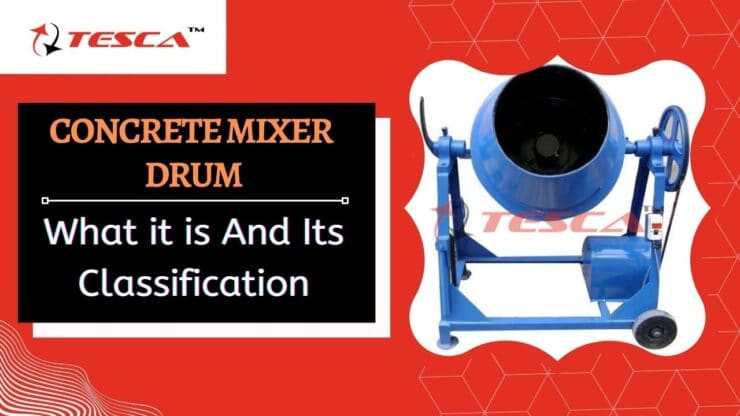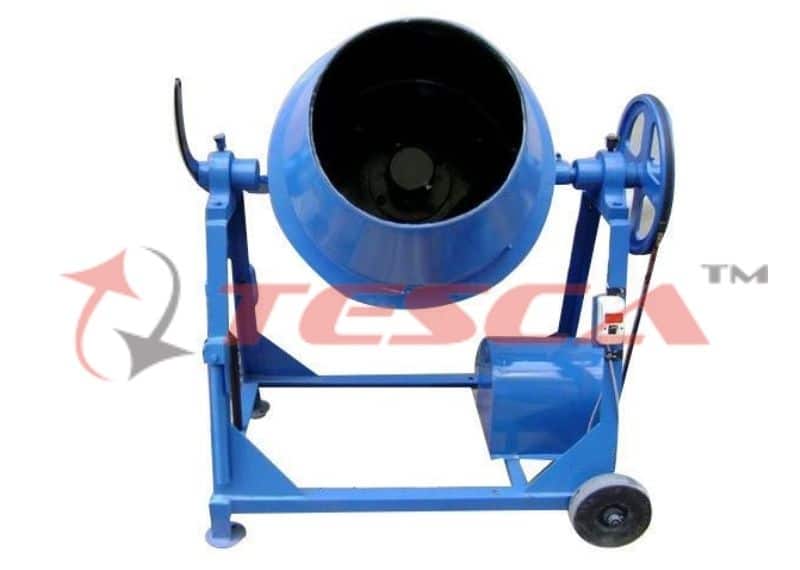Table of Contents
The concrete mixer drum is quite a helpful instrument in the construction industry. There are diverse industries where concrete mixer drums are accommodating in their projects.
This blog will look at how these drums help in multiple industries and help in substantial business.
Let us know in detail about this machine here:
Concrete Mixer Drum: What it is and Its Classification
Concrete mixer drums help in many types of work: constructing roads, bridges, buildings, etc.
So let’s discuss the concrete mixer drum in detail and its classification.
What is a Drum Type Concrete Mixer?
So what does this device do?
The concrete mixer drums are a practical mechanism in construction. It helps mix concrete materials and comes with a drum on the top of the machine. It is a machine used to construct roads, bridges, buildings, etc.
The primary function of the drum is to provide the mixed concrete with a uniform texture, which is essential for the quality of the concrete.
It is made mainly of heat-treated steel and ensures that the machine is durable and can deal with harsh environmental conditions.
Why Choose Drum Concrete Mixer over Traditional Concrete Mixer?
You may also uncover traditional ones when darting for drum concrete mixers. So why not choose a traditional one instead of drum concrete mixers. Is there any distinction between both of them inside a concrete mixer drum?
There are many reasons to choose a drum concrete mixer over a traditional one.
- First, drum concrete mixers are more efficient in mixing concrete, and they can mix concrete faster and more thoroughly, saving time and money.
- Second, drum concrete mixers are more durable and withstand more wear and tear. They are also more manageable to retain and are suitable for extended periods.
- Third, drum concrete mixers are more versatile and are helpful for various applications.
- Fourth, drum concrete mixers are more affordable than traditional concrete mixers.
- Fifth, drum concrete mixers are easier to operate, and anyone can use them.
- Sixth, drum concrete mixers are more environmentally friendly than traditional concrete mixers.
- Seventh, drum concrete mixers are obtainable in diverse dimensions and can be customized to meet specific requirements.
- Lastly, drum concrete mixers also come with a warranty and are robust.
The Concrete Mixer Drums are Most Suited for:
The concrete mixer drum is most suited for mixing large batches of concrete inside a concrete mixer drum. The drum can spin to combine the concrete evenly, and the concrete can be flowed into the drum to blend it.
The concrete mixer drum is also ideal for mixing concrete with a large aggregate.
Specifications of Concrete Mixer Drums:
Let us understand some of the broad range of features of Concrete Mixer Drums:
- A concrete mixer drum is a cylindrical container that revolves about its longitudinal axis during mixing.
- The usual specifications of concrete mixer drums include a diameter of 4 to 7 feet, a length of 15 to 18 feet, and a volume of 28 to 45 cubic yards. The drum maybe stainless steel or lined with wear-resistant materials.
- The drum typically has a capacity of anywhere from 50 to 100 gallons.
- It is often equipped with a pour spout or chute to quickly pour the concrete into another container or the desired location.
Read Also: Concrete Test Hammer: Working Principles, Objectives, Uses
Classifications of Drum Type Concrete Mixers:
There are three main types of drum concrete mixers:
- Tilting drum mixers.
- Non-Tilting drum mixers.
- Reversing drum mixers.
These differ as per the concrete mixer drum liners, concrete mixer drums weight, concrete mixer drums flap, concrete mixer drums roller, etc.
Tilting mixers allow for the easy dumping of the concrete mix, while non-tilting mixers require the operator to tilt the drum to pour out the mix manually.
Reversing drum mixers have a drum that rotates in one direction for mixing and in the reverse direction for discharging the mixture.
Let us know more about it here:
1. Tilting Mixers:
Tilting drum concrete mixers are concrete mixers that tilt to pour the concrete out. A tilting drum concrete mixer is valuable construction equipment for mixing concrete.
It constitutes a rotating/spinning drum obtainable for coursing the concrete. The tilting action allows for a more even flow, preventing the concrete from getting stuck in the mixer.
Tilting drum concrete mixers are available in various sizes, and they are helpful for both small and large projects. The machine delivers concrete by gravity, and because of this, segregation doesn’t occur.
2. Non-Tilting Mixers:
Non-Tilting drum mixers do not allow any tilt for different angles, meaning the drum cannot rotate about any axis besides its horizontal one.
There are two ways concrete can be discharged inside a concrete mixer drum, in this case: directly channeled from the mixer’s opening or a side panel that closes off the door.
However, as concrete is funneled through one end and collected by another, none of these methods completely prevents segregation, which may occur with tilt drum mixers.
The mixing particles more than 7.5 cm are challenging to discharge without mixtures clogging up the drum; thus, the water should exclude or break down larger aggregate when using this mixer because this classification of mixer takes longer than tilt drum mixers to discharge concrete.
They’re often beneficial on projects where time restrictions are not so high since they’re still able to stand up to the task of mixing relatively small batches of mortar compounds just fine!
3. Reversing Drum Mixer:
Reversing drum mixers are different from traditional style mixers in that they don’t tilt side to side. Instead, the drum horizontally spins proximate to the axis.
It dispenses material from the opening on one end of the drum and into a trough on the other end.
Standard reverse drum mixers ship with two blades specifically designed for mixing or else discharging.
Though this type of equipment may seem similar to a cement mixer, it is helpful for dry goods such as concrete powders or rosin, not cement itself.
Tesca Global’s Drum Type Concrete Mixer:
There are considerable concrete mixer drum manufacturers available. But when we talk about a reliable one, Tesca Global has its supremacy in the market.
As a leading supplier and manufacturer of the concrete mixer drums, Tesca Global’s products are valuable in diverse industries such as building, machinery manufacturing, highway structure, etc.
Tesca, a top manufacturer of concrete mixers, proposes a broad range of derivatives, including drum-type concrete mixers, Tilt concrete mixers, etc.
The features of these products are:
- The TESCA concrete mixer drums are of high-quality steel, with the highest requirements for strength and durability.
- The drum provides many advantages: it is lighter in weight than other materials, with less fuel during transport.
- Tesca produces concrete mixer drums by using high-strength steel.
- They come in various sizes and capacities to suit a variety of mixed proportions. It can disassemble for easy cleaning, painting, or making modifications.
- Tesca’s Drum Type Concrete Mixer is usually valid for work that requires a high-volume or quality concrete delivery.
So if you are looking for reliable and robust equipment for your workspace, go for Tesca Global, as they offer the best devices at a reasonable price.
FAQs:
How Considerably is The Concrete Mixer Drum Weight?
The concrete mixer drum’s weight is essential when determining any concrete mixer. The importance of the drum will determine the amount of concrete that the device can mix at one time.
A heavier drum will incorporate more substantial, while a lighter drum will be able to mix less concrete. On average, the weight is around 220.4 lbs.
How does a Concrete Mixer Drum Flap Course?
A concrete mixer drums flap is a movable piece of equipment used to mix concrete. The flap attached to the mixer’s drum helps stir the concrete while combining the material.
The flap is of a material resistant to wear and tear and is also lubricated to prevent friction. The flap operates with the help of a handle that is attached to the flap. The grip helps rotate the flap, which in turn stirs the concrete.
How do Concrete Mixer Drums Roller Work?
The concrete mixer drums roller is an essential part of the concrete mixer, as they help rotate the drum. The rollers can withstand the weight of the concrete and the constant movement.
The rollers are usually on a frame attached to the mixer, and a motor drives them. The rollers rotate at high speed, and they can quickly move the heavy drum.
How Much Does a Drum Type Concrete Mixer Machine Cost?
Several things contribute to the cost: Size, type, and several tires; drum size and type; engine or electric operation; digital or manual process, devices such as 8cbm concrete mixer drums, etc.
The pricing starts at INR 40,000 but usually ranges between INR 1 lakh and INR 10 lakhs.
How to Clean hardened Concrete Mixer Drum?
If your concrete mixer drums have become dry due to the dry mixture, you can use a few methods to scrub them. One way is to use a putty knife or chisel to chip away at the dried concrete.
Another approach is to wash the drum in a tub of water for a few hours and then cleanse it with a brush. If the hardened concrete is stubborn, you may need a power washer to remove it.






Add comment